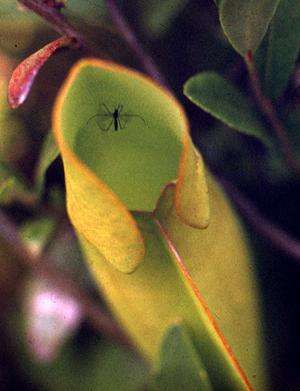(Phys.org)—A comprehensive study at the University of Oregon, using cutting-edge genetic tools, shows that temperate and polar species of animals may be much more resilient to rapid climate change than previously expected.
Thousands of species in temperate zones read the length of day—or photoperiodism—to cue irrevocable life and death behaviors, including the timing of development in the spring, when to enter dormancy in the fall, when to reproduce and when to migrate.
In the new study, a team of biologists in the lab of William E. Bradshaw and Christina Holzapfel studied ancient and derived populations of the pitcher-plant mosquito, Wyeomyia smithii. Researchers created three forms of genetic maps of mosquitoes from New Jersey, northern Maine and southern Alabama. This species of mosquito completes its pre-adult development in the water-filled leaves of the purple pitcher plant.
The research team found that the underlying genetic architecture of photoperiodism is highly variable, not only through evolutionary time but also within populations. Species have a high level of built-in genetic flexibility with which to respond to the seasonal demands of a changing world, a fact that co-author Holzapfel said "will provide more challenges than previously expected in efforts to control unwanted pests and invasive species in temperate climates."
Bradshaw and Holzapfel had shown earlier that an interpretation of length of day by animals is coded in the genes and can be shifted in as few as five years in response to climate change. Their ongoing project seeks the basis for the evolution of seasonal timing at the level of genes and an understanding of how the integration of genes has changed over geographical ranges and over different evolutionary time scales.
Bradshaw, the lead author in the new study, said that "gaining such genetic knowledge is key to predicting and mitigating the movement of vector-borne diseases from tropical to temperate zones of Earth as vectors and their hosts migrate into increasingly milder northern climates."
"This research by Drs. Bradshaw and Holzapfel and their group is furthering our understanding of how different species are responding to climate change," said Kimberly Andrews Espy, UO vice president for research and innovation, and dean of the graduate school. "The modern genetic analysis tools being used by these researchers, some of which were developed here at the University of Oregon, are helping to yield solutions to tomorrow's problems today."
The new paper is titled "Footprints in time: comparative quantitative trait loci mapping of the pitcher-plant mosquito, Wyeomyia smithii" and was placed online ahead of regular publication by the Proceedings of the Royal Society B.
Journal information: Proceedings of the Royal Society B
Provided by University of Oregon




















